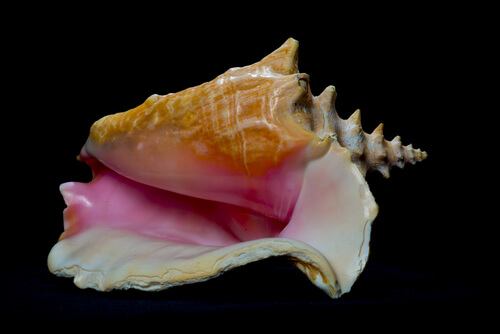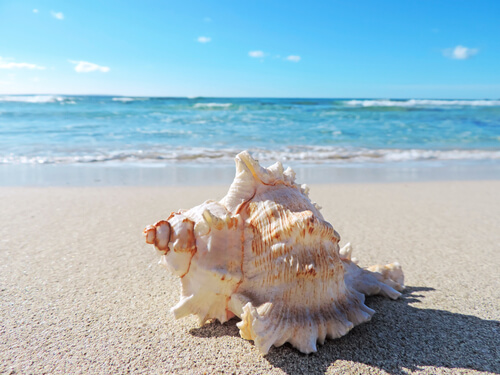
| Kingdom | Animalia |
| Phylum | Mollusca |
| Class | Gastropoda |
| Order | Mesogastropoda |
| Family | Strombidae (“True Conches”), Melongenidae, Fasciolariidae, Turbinellidae, Charoniidae |
| Genus | Strombus, Aliger, Laevistrombus, others |
| Species | Various |
| Niche | Benthic Herbivore |
| Length | 13.9 in (35.2 cm) |
| Weight | 5 lbs (2.3 kg) |
| Lifespan | 20-30 |
| Conservation Status | Threatened |
| Preferred Habitat | Seagrass beds |
| Average Clutch Size | 180,000-460,000 eggs |
| Main Food Items | Algae, decaying plant matter |
| Predators | Predatory sea snails |
The Basics
Conch refers to several species of marine gastropods with medium or large spired and ornate shells. Typical species include the queen conch (Aliger gigas) of the family Strombidae. These are also referred to as “true conches”, however. members of Melongenidae and Fasciolariidae contain species that are commonly referred to as conches as well. Their shells are commonly used as instruments, decorations, or for other cultural purposes while their meat is the inspiration for famous dishes in many cultures, particularly in the Caribbean.
General Description
Besides the queen conch, another well-known member of the family Strombidae is the dog conch (Laevistrombus canarium). However, several species of the genus Melongena as well as the horse conch (Triplofusus papillosus), although quite distantly related to “true conches”, are also captured under the term. The word conch is derived from Latin and Greek words meaning ‘shellfish’, hence the relative ambiguity in its modern-day meaning.

All conches are sea snails and, much like terrestrial snails, they have a large, muscular ‘foot’ that they use for mobility and to attach to the seafloor or ‘substrate’. They are also protected by a hard calcareous shell. The queen conch lives in the Caribbean Sea and grows up to 13.9 in (35.2 cm) in length and weighs up to 5 lb (2.3 kg) including its shell. They prefer seagrass beds which are typically found in sandy areas in shallow marine waters. All members of the family Strombidae have a long snout with two eyestalks used to detect light and other visual cues. There are also other additional sensory tentacles used to effectively ‘smell’ potential food sources, predators, and habitat opportunities.
Diet and Predators
Conch are herbivorous and feed on algal (plant) material found in seagrass beds. They will also feed on other decaying organic matter such as seaweeds or terrestrial plants swept into the marine environment. Their shells are large and heavy, and notoriously solid. The lip of the aperture is flared, and the outside of the shell is covered in knob and spine-like structures.

Despite protection from their strong, thick shells, conch such as the queen conch are still victims of predation by various species. For example, other sea snail species are predatory and use powerful enzymes and a drill-like appendage to bore a hole in the shell of others. Conch are common victims to several of these large species of sea snails.
Also, various species of octopus will attack the conch, removing it from its shell with its tentacles and hard beak. Various crustaceans, fish, and sea turtles will also feed on conches, especially when they are younger and their shells are softer and less developed. Finally, nurse sharks will also feed on conches. Given so many predators in its natural environment, it is easy to see why it has evolved such a hard, thick shell for as much protection as is possible. In addition to many natural predators, conches have also been harvested by humans since before recorded history. This is problematic in some regions, where conch species are becoming threatened due to the overharvesting of these long-lived animals.
Reproduction and Development
Female conches are typically larger than males. Copulation occurs via internal fertilization, and females will lay eggs throughout the seagrass beds in gelatinous strings than can be as long as 75 ft (23 m). The size and shape of these egg masses vary with environmental conditions but most females will lay up to 8 or 9 clutches per breeding season, each containing 180,000-460,000 eggs.
3-5 days later the embryos will hatch. These tiny animals are translucent with some creamy markings. These eventually join the plankton – plants and animals at the whim of the sea currents – until metamorphosis occurs at about 16-40 days of age. Following this, conches spend their lives as benthic animals, meaning they are always on the bottom attached to a surface rather than floating or swimming in the water column. Conches reach sexual maturity at about 3-4 years old and may live as long as 20-30 years.
Fun Facts about Conch!
Given their attractive shells and delicious meat, conches have been interacting with humans for millennia, inspiring cultures of food, music, and more.
Conch Fine Dining
Conch meat is common in various diets around the world. For example, in the Bahamas, where queen conch is commonly found, it is often served in a fritter form as well as soups and salads. In Puerto Rico, it is common in a ceviche dish of seafood ‘cooked’ in lemon juice, and in other Caribbean countries, curries and soups are prepared with the animal’s meat. It is enjoyed both raw or cooked.
It is also popular across the Atlantic such as in Italy where it is known as scungille. Here, it is consumed in a variety of salad dishes and pasta sauces while In Asia it is commonly consumed in thin steamed or stir-fried slices.
The Sound of Conch
The conch’s shell may be more well known than the animal itself. It is famous for its ornamental appearance and its impressive strength. In addition, it is commonly used as a musical instrument in various cultures around the world.

To use the shells as wind instruments, it is normally necessary to form a hole in the spire of the shell near the apex. Then, when blown into like a trumpet, the shell emits a horn-like sound. Some users will utilize a mouthpiece, and the pitch of each shell can be changed by altering the positions of one’s hands over the aperture in the shell. The queen conch is the most typical species, and its shell is one of the most commonly used as an instrument.
A Hidden Gem
Like many mollusks, some conch species produce pearls within their shells. The pearls of the queen conch are indeed very rare and sought after for use in jewelry and art. These pearls can occur in various colors including white, brown, orange, or pink.
Pearls, like the shells of mollusks themselves, are a fascinating natural occurrence. Much like the shell, it is made of calcium carbonate, which is present in the animal’s environment and utilized by them to form these inorganic structures. However, unlike shells which protect animals exteriors, it is produced within the soft tissue of these animals. They are sought after as gemstones, despite their marine and living origins.
A Home to Others
Not only are conch shells used by humans as instruments and more, but they are also popular among other animals that like to utilize the shell. Indeed, conch form commensal relationships with several animals, in which the animals effectively live together. In this case, the conch provides shelter – its protective shell.
Conch shells often become homes to many species including slipper snails and porcelain crabs, and a species of fish known as the conchfish (Astrapogon stellatus). These animals will take up residence inside the large shell and use it for protection against predators and harsh conditions. Some species will also utilize the shells as a ‘residence’ once the conch has died and left it for use by others.
